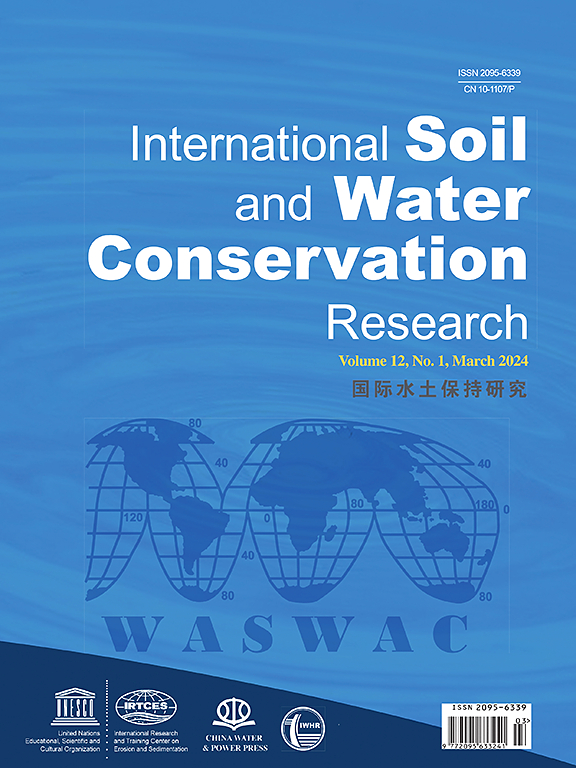Hedgerow-grass ditch system effectively reduces sediment yield and nitrogen loss with surface runoff during simulated rainfall
IF 7.3
1区 农林科学
Q1 ENVIRONMENTAL SCIENCES
International Soil and Water Conservation Research
Pub Date : 2025-04-02
DOI:10.1016/j.iswcr.2025.03.006
引用次数: 0
Abstract
Hedgerow-grass ditch systems combine the advantages of contour planting and ecological grass ditches and have better soil and water conservation (SWC) benefits; however, there is a lack of a comprehensive understanding of their combined effects on sediment yield (SY) and N loss with surface runoff. To study the efficient management of hedgerow-ditch system runoff and nutrient loss in sloping farmland, an adjustable slope with a gradient of 15° and a drainage ditch with a gradient of 16° were used under typical erosive rainfall of 60 mm h−1. Four treatments, including control check (CK), bare slope (a slope without hedgerow and ditch system); T1, hedgerow slope (a hedgerow slope without a ditch system); T2, bare slope-soil ditch system (a bare slope with a soil ditch system); and T3, hedgerow-grass ditch system (a slope with hedgerow and a grass ditch system), were used to assess their impacts on runoff depth (RD), infiltration rate, sediment yield, and the concentration and loss quantities of total nitrogen (TN), dissolved nitrogen (DN), and particulate nitrogen (PN) and DN/TN in runoff. The results indicated that, compared with CK, the RD under T1, T2, and T3 were significantly decreased by 16.6 %, 14.4 %, and 54 %, respectively. The infiltration amounts under T1, T2, and T3 were significantly increased by 52.9 %, 45.7 %, and 171.9 %, respectively. The sediment concentration and SY rate were significantly reduced by 69.9 % and 94.9 %, and 22.1 % and 93.3 % under T1 and T3, respectively, but increased by 43.9 % and 274.7 % under T2 relative to CK. The diverse forms nitrogen (TN, DN, and PN) concentrations and losses under T3 were significantly reduced by 21 %, 10.4 %, 30.2 %, and 64.6 %, 57.6 %, and 67.1 %, respectively. The runoff DN/TN ratio was 53 %, revealing that DN was the primary type of N loss. Regression analysis showed that the RD exerted a more pronounced influence on TN loss across the four treatments, and a power function (R2 > 0.98, p < 0.01) of the cumulative RD could be used to predict TN, DN, and PN losses. Principal component analysis demonstrated that the hedgerow-grass ditch system affected slope nitrogen loss by changing the infiltration rate and DN/TN ratio. Our study demonstrates that the hedgerow-grass ditch system effectively reduced the sediment yield and N loss and could be used as an effective means of N control on sloping farmlands.

在模拟降雨过程中,篱草沟渠系统有效地减少了地表径流的产沙量和氮流失
植物篱-草沟系统结合了等高线种植和生态草沟的优点,具有较好的水土保持效益;然而,对它们对地表径流产沙量(SY)和氮损失的综合影响缺乏全面的认识。为研究坡耕地篱沟系统径流和养分流失的有效管理,在典型侵蚀降雨量为60 mm h−1的条件下,采用坡度为15°的可调坡道和坡度为16°的排水沟。4种处理,包括控制检查(CK)、裸坡(没有树篱和沟渠系统的斜坡);T1,篱坡(无沟渠系统的篱坡);T2,裸坡-土沟系统(带土沟系统的裸坡);以植物篱-草沟系统T3(有植物篱和草沟系统的坡面)为研究对象,评价其对径流深度(RD)、入渗速率、产沙量以及径流中总氮(TN)、溶解氮(DN)、颗粒氮(PN)和DN/TN的浓度和损失量的影响。结果表明,与对照相比,T1、T2和T3处理下的RD分别显著降低了16.6%、14.4%和54%。T1、T2和T3下的入渗量分别显著增加了52.9%、45.7%和171.9%。与对照相比,T1和T3处理显著降低了含沙量69.9%和94.9%,显著降低了22.1%和93.3%,而T2处理则显著增加了43.9%和274.7%。不同形态氮素(TN、DN和PN)浓度和损失在T3处理下分别显著降低了21%、10.4%、30.2%、64.6%、57.6%和67.1%。径流DN/TN比值为53%,表明DN是主要的N损失类型。回归分析表明,在4个处理中,RD对全氮损失的影响更为显著,呈幂函数(R2 >;0.98, p <;累积RD的0.01)可用于预测TN、DN和PN的损失。主成分分析表明,植物篱-草沟系统通过改变入渗速率和DN/TN比影响坡面氮素损失。研究表明,篱草沟渠系统能有效降低坡耕地的产沙量和氮素损失,可作为坡耕地氮素控制的有效手段。
本文章由计算机程序翻译,如有差异,请以英文原文为准。
求助全文
约1分钟内获得全文
求助全文
来源期刊

International Soil and Water Conservation Research
Agricultural and Biological Sciences-Agronomy and Crop Science
CiteScore
12.00
自引率
3.10%
发文量
171
审稿时长
49 days
期刊介绍:
The International Soil and Water Conservation Research (ISWCR), the official journal of World Association of Soil and Water Conservation (WASWAC) http://www.waswac.org, is a multidisciplinary journal of soil and water conservation research, practice, policy, and perspectives. It aims to disseminate new knowledge and promote the practice of soil and water conservation.
The scope of International Soil and Water Conservation Research includes research, strategies, and technologies for prediction, prevention, and protection of soil and water resources. It deals with identification, characterization, and modeling; dynamic monitoring and evaluation; assessment and management of conservation practice and creation and implementation of quality standards.
Examples of appropriate topical areas include (but are not limited to):
• Conservation models, tools, and technologies
• Conservation agricultural
• Soil health resources, indicators, assessment, and management
• Land degradation
• Sustainable development
• Soil erosion and its control
• Soil erosion processes
• Water resources assessment and management
• Watershed management
• Soil erosion models
• Literature review on topics related soil and water conservation research
 求助内容:
求助内容: 应助结果提醒方式:
应助结果提醒方式:


